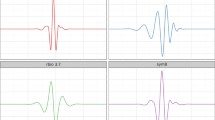Abstract
Biological populations can be monitored through acoustic signal processing. This approach allows to sense biological populations without a direct interaction between humans and species required. In order to extract relevant acoustic features, signals must be processed through a noise reduction stage in which target data is enhanced for a better analysis. Due to the nature of the biological acoustic signals, the denoising strategy must consider the non-stationarity of the records and minimize the lost of significant information. In this work, a Last Approximation standard deviation algorithm (LAstd) for the processing of bioacoustic signals based on wavelet analysis is presented. The performance of the proposed algorithm is evaluated using a database of owls, which have been modified with different rates of coloured noise. Furthermore, the approach is compared to a standard denoising method from the Matlab Wavelet Toolbox. The results show that the proposed algorithm is able to improve the signal-to-noise ratio of the owl’s registers within a wide frequency range and different noise conditions. Furthermore, the algorithm can be adapted to process different biological species, thus it can be an useful tool for characterizing avian ecosystems.
Access this chapter
Tax calculation will be finalised at checkout
Purchases are for personal use only
Similar content being viewed by others
References
Alonso, J.B., et al.: Automatic anuran identification using noise removal and audio activity detection. Expert Syst. Appl. 72, 83–92 (2017)
Wielgat, R., Zielinski, T.P., Potempa, T., Lisowska-Lis, A., Król, D.: HFCC based recognition of bird species. In: Signal Processing: Algorithms, Architectures, Arrangements, and Applications, SPA 2007 - Workshop Proceedings, pp. 129–134 (2007)
Bedoya, C., Isaza, C., Daza, J.M., López, J.D.: Automatic recognition of anuran species based on syllable identification. Ecol. Inform. 24, 200–209 (2014)
Chen, G., Bui, T.: Multiwavelets denoising using neighboring coefficients. IEEE Signal Process. Lett. 10, 211–214 (2003)
Priyadarshani, N., Marsland, S., Castro, I., Punchihewa, A.: Birdsong denoising using wavelets. PLoS ONE 11, e0146790 (2016)
Jing-Yi, L., Hong, L., Dong, Y., Yan-Sheng, Z.: A new wavelet threshold function and denoising application. Math. Probl. Eng. 2016, 8 p. (2016)
Srivastava, M., Anderson, C.L., Freed, J.H.: A new wavelet denoising method for selecting decomposition levels and noise thresholds. IEEE Access 4, 3862–3877 (2016)
Patil, R.: Noise reduction using wavelet transform and singular vector decomposition. Procedia Comput. Sci. 54, 849–853 (2015)
Blanco, S., Garay, A., Coulombie, D.: Comparison of frequency bands using spectral entropy for epileptic seizure prediction. ISRN Neurol. 2013, 5 p. (2013)
Varady, P.: Wavelet-based adaptive denoising of phonocardiographic records. In: 2001 Conference Proceedings of the 23rd Annual International Conference of the IEEE Engineering in Medicine and Biology Society, vol. 2, pp. 1846–1849 (2001)
Donoho, D.L., Johnstone, J.M.: Ideal spatial adaptation by wavelet shrinkage. Biometrika 81, 425–455 (1994)
Brown, A., Garg, S., Montgomery, J.: Automatic and efficient denoising of bioacoustics recordings using MMSE STSA. IEEE Access 6, 5010–5022 (2017)
Ranjard, L., et al.: MatlabHTK: a simple interface for bioacoustic analyses using hidden Markov models. Methods Ecol. Evol. 8, 615–621 (2017). Cited By 1
Gur, B.M., Niezrecki, C.: Autocorrelation based denoising of manatee vocalizations using the undecimated discrete wavelet transform. J. Acoust. Soc. Am. 122, 188–199 (2007)
Ren, Y., Johnson, M.T., Tao, J.: Perceptually motivated wavelet packet transform for bioacoustic signal enhancement. J. Acoust. Soc. Am. 124, 316–327 (2008)
Mallat, S.: A theory for multiresolution signal decomposition: the wavelet representation. IEEE Trans. Pattern Anal. Mach. Intell. 11, 674–693 (1989)
Yang, J., Park, S.-T.: An anti-aliasing algorithm for discrete wavelet transform. Mech. Syst. Signal Process. 17, 945954 (2003)
Shannon, C.E.: A mathematical theory of communication. Bell Syst. Tech. J. 27, 379–423 (1948)
Wang, D., Miao, D., Xie, C.: Best basis-based wavelet packet entropy feature extraction and hierarchical EEG classification for epileptic detection. Expert. Syst. Appl. 38, 14314–14320 (2011)
Ma, H., Dang, J., Liu, X.: Research of the optimal wavelet selection on entropy function. In: Deng, W. (ed.) Future Control and Automation. LNEE, vol. 173, pp. 35–42. Springer, Berlin (2012). https://doi.org/10.1007/978-3-642-31003-4_5
Donoho, D.: De-noising by soft-thresholding. IEEE Trans. Inf. Theory 41, 613–627 (1995)
Halley, J., Inchausti, P.: The increasing importance of 1/f-noises as models of ecological variability. Fluct. Noise Lett. 4, 1–26 (2004). Cited By 43
Vasseur, D., Yodzis, P.: The color of environmental noise. Ecology 85, 1146–1152 (2004). Cited By 177
Author information
Authors and Affiliations
Corresponding author
Editor information
Editors and Affiliations
Rights and permissions
Copyright information
© 2018 Springer Nature Switzerland AG
About this paper
Cite this paper
Gómez, A., Ugarte, J.P., Gómez, D.M.M. (2018). Bioacoustic Signals Denoising Using the Undecimated Discrete Wavelet Transform. In: Figueroa-García, J., Villegas, J., Orozco-Arroyave, J., Maya Duque, P. (eds) Applied Computer Sciences in Engineering. WEA 2018. Communications in Computer and Information Science, vol 916. Springer, Cham. https://doi.org/10.1007/978-3-030-00353-1_27
Download citation
DOI: https://doi.org/10.1007/978-3-030-00353-1_27
Published:
Publisher Name: Springer, Cham
Print ISBN: 978-3-030-00352-4
Online ISBN: 978-3-030-00353-1
eBook Packages: Computer ScienceComputer Science (R0)




